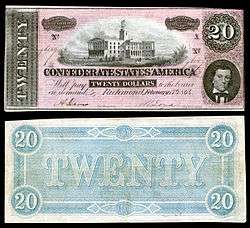Tennessee State Capitol
|
Tennessee State Capitol | |
|
Tennessee State Capitol | |
  | |
| Location |
Capitol Hill Nashville, Tennessee |
|---|---|
| Coordinates | 36°9′57″N 86°47′3″W / 36.16583°N 86.78417°WCoordinates: 36°9′57″N 86°47′3″W / 36.16583°N 86.78417°W |
| Area | 4.9 acres (2.0 ha) |
| Built | 1845-1859 |
| Architect | William Strickland |
| Architectural style | Greek Revival |
| NRHP Reference # | 70000894 |
| Significant dates | |
| Added to NRHP | July 8, 1970[1] |
| Designated NHL | November 11, 1971[2] |
The Tennessee State Capitol, located in Nashville, Tennessee, is the home of the Tennessee legislature, the location of the governor's office, and a National Historic Landmark. Designed by architect William Strickland, it is one of Nashville's most prominent examples of Greek Revival architecture. It is one of only twelve state capitols (along with those of Alaska, Delaware, Florida, Hawaii, Louisiana, Nebraska, New Mexico, New York, North Dakota, Ohio, and Virginia) that does not have a dome.
Design and construction

The prominent Nashville hill top site of what is now the Tennessee State Capitol was formerly occupied by the Holy Rosary Cathedral (no longer extant), the first Roman Catholic cathedral church in Nashville (with the Diocese of Nashville at that time once comprising the entire territory of the State of Tennessee).[3][4][5]
The State Capitol was designed by renowned Philadelphia architect William Strickland, who modeled it after a Greek Ionic temple. The prominent lantern structure located above the roof line of the Tennessee state capitol is a design based upon the Choragic Monument of Lysicrates in Athens that honors the Greek god Dionysus doing battle with Tyrrhenian pirates.[6] The cornerstone of the Tennessee state capitol was itself laid on July 4, 1845 and the building was completed fourteen years later in 1859.[7]
The American Society of Civil Engineers has listed the building as a civil engineering landmark in recognition of its innovative construction, which made unusually extensive use of stone and was an early example of the use of structural iron. Both the interior and exterior are built with limestone from a quarry about 1 mile (1.6 km) from the site. Some interior columns were built from single pieces of stone, requiring massive wooden derricks to hoist them into place. Wrought iron, instead of wood, was used for the roof trusses to reduce the building's vulnerability to fire.[8]
Tennessee State Capitol depicted on a 1864 Confederate $20 banknote
Commercial, convict, and slave labor were used in the project. Fifteen enslaved Black men worked on carving the Capitol's limestone cellar from 1845 to 1847; Nashville stonemason A.G. Payne was paid $18 a month for their labor. It is believed to be "the most significant project where the [Tennessee] state government rented slave labor."[9]
Strickland died five years before the building's completion and was entombed in its northeast wall. His son, F. W. Strickland, supervised completion of the structure. William Strickland also designed the St. Mary’s Cathedral (located along the base of the capitol hill), as well as Downtown Presbyterian church located just a few blocks away from the state capitol.[10]
Samuel Dold Morgan (1798–1880), chairman of the State Building Commission overseeing the construction of the Tennessee State Capitol, is entombed in the southeast corner near the south entrance.
Monuments
Monuments on the Capitol grounds include statues of two of the three Tennessee residents who served as President of the United States: Andrew Jackson by Clark Mills and Andrew Johnson by Jim Gray. The second President from Tennessee, James K. Polk, is buried in a tomb on the grounds, together with his wife, Sarah Childress Polk. Other monuments on the grounds include the Sgt. Alvin C. York Memorial by Felix de Weldon, the Tennessee Holocaust Commission Memorial, the Sam Davis Memorial at the southwest corner of the Capitol grounds, the Sen. Edward Ward Carmack Memorial located above the Motlow Tunnel near the south entrance, and the Memorial to Africans during the Middle Passage at the southwest corner of Capitol grounds. The Charles Warterfield Reliquary is a group of broken limestone columns and fragments removed and saved from the State Capitol during the mid-1950s restoration, located near the northern belvedere on Capitol Drive.
 Inside the House Chamber from the viewing gallery
Inside the House Chamber from the viewing gallery Inside the House Chamber as seen from the floor
Inside the House Chamber as seen from the floor Andrew Jackson Statue located on the grounds of the Tennessee State Capitol
Andrew Jackson Statue located on the grounds of the Tennessee State Capitol Night time view of the Capitol
Night time view of the Capitol
References
- ↑ National Park Service (2009-03-13). "National Register Information System". National Register of Historic Places. National Park Service.
- ↑ "Tennessee State Capitol". National Historic Landmark summary listing. National Park Service. Retrieved 2009-09-03.
- ↑ http://www.waymarking.com/waymarks/WMGGDD_FIRST_Catholic_Church_in_Tennessee_Nashville_Tennessee "FIRST - Catholic Church in Tennessee - Nashville, Tennessee - First of its Kind on Waymarking.com"
- ↑ http://tnsjournal.com/capitols-churches/capitols-and-cd-in-nashville/ "Capitols and churches: Built and buried in Nashville", Tennessee Star Journal.
- ↑ http://www.newadvent.org/cathen/10704c.htm Lorigan, J.T. (1911). Nashville. In The Catholic Encyclopedia. New York: Robert Appleton Company. Retrieved March 1, 2016 from New Advent.
- ↑ http://famouswonders.com/choragic-monument-of-lysicrates/ "Choragic Monument of Lysicrates".
- ↑ The Tennessee State Capitol: A Self-Guided Walking Tour. Tennessee State Museum. 2009.
- ↑ Tennessee State Capitol, History & Heritage of Civil Engineering, American Society of Civil Engineers website
- ↑ Iv, Thomas Joseph Broderick (2008-06-03). "They Moved the Earth: The Slaves Who Built the Tennessee State Capitol". Vanderbilt Undergraduate Research Journal. 4. ISSN 1555-788X. Retrieved 2015-02-23.
- ↑ http://tnsjournal.com/capitols-churches/capitols-and-cd-in-nashville/ "Capitols and churches: Built and buried in Nashville".
External links
| Wikimedia Commons has media related to Tennessee State Capitol. |
- Tennessee State Museum - State Capitol information
- Tennessee Legislature Website
- Documentary: Tennessee State Capitol - Grounded in Tradition

